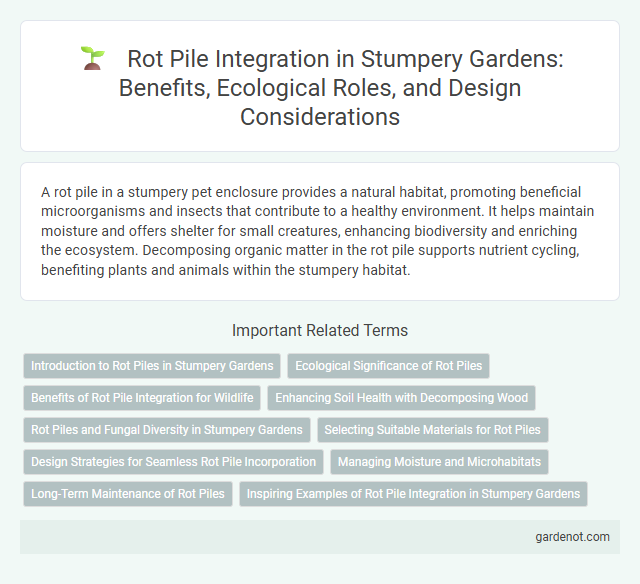A rot pile in a stumpery pet enclosure provides a natural habitat, promoting beneficial microorganisms and insects that contribute to a healthy environment. It helps maintain moisture and offers shelter for small creatures, enhancing biodiversity and enriching the ecosystem. Decomposing organic matter in the rot pile supports nutrient cycling, benefiting plants and animals within the stumpery habitat.
Introduction to Rot Piles in Stumpery Gardens
Rot piles in stumpery gardens serve as vital microhabitats that accelerate organic matter decomposition and enrich soil nutrients. Composed of layered wood debris, leaves, and fungal activity, these piles support biodiversity by providing shelter for insects, fungi, and microorganisms. Integrating rot piles enhances the ecological balance of stumperies, promoting healthier soil structure and plant growth.
Ecological Significance of Rot Piles
Rot piles create vital habitats for decomposers such as fungi, insects, and microbes, accelerating nutrient cycling and soil formation. These decaying wood structures enhance biodiversity by supporting various species essential for ecosystem balance. Their ecological function contributes to carbon sequestration and helps maintain forest health through organic matter breakdown.
Benefits of Rot Pile Integration for Wildlife
Rot piles create essential microhabitats that support diverse wildlife, from insects to small mammals and amphibians. The decomposition process enriches soil quality, promoting plant growth and enhancing ecosystem stability. Integrating rot piles in a stumpery fosters biodiversity by providing shelter, food sources, and breeding grounds for various species.
Enhancing Soil Health with Decomposing Wood
Rot piles utilize decomposing wood to enrich soil health by accelerating nutrient cycling and improving soil structure. The breakdown of wood fibers releases essential minerals like nitrogen, phosphorus, and potassium, fostering microbial activity vital for plant growth. Incorporating rot piles in stumpery designs promotes sustainable garden ecosystems by naturally boosting soil fertility and moisture retention.
Rot Piles and Fungal Diversity in Stumpery Gardens
Rot piles in stumpery gardens create essential habitats that boost fungal diversity by providing decaying wood as a nutrient-rich substrate. These piles support saprophytic fungi species, which play a critical role in breaking down organic matter and enriching soil health. Monitoring fungal diversity within rot piles can reveal insights into ecosystem dynamics and contribute to conservation efforts in stumpery garden environments.
Selecting Suitable Materials for Rot Piles
Choosing appropriate materials for rot piles involves selecting hardwood logs, branches, and bark that decompose slowly, providing a stable habitat for shade-loving ferns and mosses common in a stumpery. Incorporating a mix of twigs, leaves, and wood chips enhances microbial activity and accelerates decomposition, enriching soil nutrients. Avoid treated or diseased wood to prevent harmful chemicals or pathogens from disrupting the delicate ecosystem within the rot pile.
Design Strategies for Seamless Rot Pile Incorporation
Rot pile integration in stumpery design focuses on strategic placement of decomposing wood to enhance natural aesthetics and support biodiversity. Utilizing varied wood sizes and layering techniques encourages diverse microhabitats while maintaining visual cohesion and structural stability. Emphasizing gradual decay patterns ensures seamless blending with living plants and surrounding natural elements.
Managing Moisture and Microhabitats
Rot piles in stumperies play a crucial role in managing moisture levels, providing a damp and humid environment that supports diverse microhabitats for fungi, invertebrates, and microorganisms. Effective moisture retention is achieved through the layered arrangement of decaying wood and organic matter, which absorbs rainfall and slowly releases it, maintaining consistent dampness. These conditions foster nutrient-rich microhabitats essential for decomposer species, enhancing biodiversity and accelerating the natural breakdown of woody debris.
Long-Term Maintenance of Rot Piles
Long-term maintenance of rot piles requires regular monitoring of moisture levels to ensure optimal decomposition and prevent fungal overgrowth that can disrupt ecosystem balance. Incorporating diverse woody materials enhances habitat complexity, supporting beneficial invertebrates and soil microbes crucial for nutrient cycling. Periodic turning of the pile aerates the material, accelerating decay and maintaining structural integrity over extended periods.
Inspiring Examples of Rot Pile Integration in Stumpery Gardens
Rot piles, consisting of decomposing wood and organic matter, create nutrient-rich habitats that enhance soil fertility and support diverse wildlife in stumpery gardens. Incorporating rot piles not only promotes natural decomposition processes but also fosters a thriving ecosystem by attracting fungi, insects, and beneficial microbes. Examples of successful rot pile integration showcase their role in enhancing plant health and maintaining ecological balance within stumperies.
Rot pile Infographic

 gardenot.com
gardenot.com